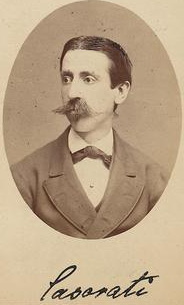Felice Casorati (nonfiction): Difference between revisions
Jump to navigation
Jump to search
(Created page with "thumb|Felice Casorati.'''Felice Casorati''' (17 December 1835 – 11 September 1890) was an Italian mathematician who studied at the University of...") |
No edit summary |
||
| Line 1: | Line 1: | ||
[[File:Felice Casorati.jpg|thumb|Felice Casorati.]]'''Felice Casorati''' (17 December 1835 – 11 September 1890) was an Italian mathematician who studied at the University of Pavia. | [[File:Felice Casorati.jpg|thumb|Felice Casorati.]]'''Felice Casorati''' (17 December 1835 – 11 September 1890) was an Italian mathematician who studied at the University of Pavia. | ||
== Biography == | |||
Casorati was born in Pavia and died in Casteggio. | |||
He is best known for the [[Casorati–Weierstrass theorem (nonfiction)|Casorati–Weierstrass theorem]] in [[Complex analysis (nonfiction)|complex analysis]]. The theorem, named for Casorati and [[Karl Weierstrass (nonfiction)|Karl Theodor Wilhelm Weierstrass]], describes the remarkable behavior of [[Holomorphic function (nonfiction)|holomorphic functions]] near [[Essential singularity )nonfiction)|essential singularities]]. | He is best known for the [[Casorati–Weierstrass theorem (nonfiction)|Casorati–Weierstrass theorem]] in [[Complex analysis (nonfiction)|complex analysis]]. The theorem, named for Casorati and [[Karl Weierstrass (nonfiction)|Karl Theodor Wilhelm Weierstrass]], describes the remarkable behavior of [[Holomorphic function (nonfiction)|holomorphic functions]] near [[Essential singularity )nonfiction)|essential singularities]]. | ||
Latest revision as of 06:16, 11 September 2020
Felice Casorati (17 December 1835 – 11 September 1890) was an Italian mathematician who studied at the University of Pavia.
Biography
Casorati was born in Pavia and died in Casteggio.
He is best known for the Casorati–Weierstrass theorem in complex analysis. The theorem, named for Casorati and Karl Theodor Wilhelm Weierstrass, describes the remarkable behavior of holomorphic functions near essential singularities.
The Casorati matrix is useful in the study of linear difference equations, just as the Wronskian is useful with linear differential equations. It is calculated based on n functions of the single input variable.
Works
- Casorati, Felice (1868), Teorica delle funzioni di variabili complesse (in Italian), Pavia: Tipografia dei Fratelli Fusi, pp. XXX+471, JFM 01.0128.05, available at Gallica (also at GDZ). Freely available copies of volume 1 of his best-known monograph, the only one ever published.
In the News
Fiction cross-reference
Nonfiction cross-reference
External links
- Felice Casorati @ Wikipedia
- O'Connor, John J.; Robertson, Edmund F. (August 2006), "Felice Casorati", MacTutor History of Mathematics archive, University of St Andrews.
